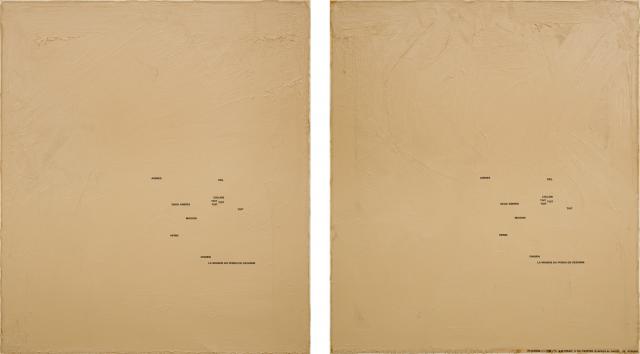Far removed from a customary representation, these two paintings provoke complex questions and a search for meaning, whose only solution is a subjective perception specific to each spectator. A key work in Rémy Zaugg’s corpus, Une feuille de papier (A Sheet of Paper) was produced at a moment when the artist’s analytical thinking crystallised, when he defined his artistic strategy by distancing himself from pictorial reproduction in order to invent a new language.
As of 1963, Zaugg became interested in the art of Paul Cézanne, the founder of modern painting, and more precisely in his work La Maison du pendu (The House of the Hanged Man) from 1873, which he would copy for five years, not according to academic norms, but following a rather conceptual approach. Zaugg reproduced Cézanne’s composition in a singular way, transforming the composition’s various formal elements into words, arranged according to the exact place that they occupied in the original painting.
These fragments of text which, in the first instance, blackened the pages of a sketchbook, soon gave rise to a series of large format paintings, whose medium, consisting of wrapping paper and covered with a light brown oil in a similar tone, became the invariable title: Une feuille de papier. Zaugg based his own artistic concept on this, according to which a painting is both a painting and a sheet of paper, the usual medium for writing, whose materiality he also glorified. These works propose an infinite variation focussing on a new pictorial space which accommodates, through print, the first notes developed by the artist about Cézanne’s painting.
The only diptych of the series, the version of the Collection Pictet has a special addition, the comment “painting based on the portrait of a painter after El Greco, by Picasso”. This evocation of a palimpsest creates a mise en abyme characteristic of Zaugg’s oeuvre, for he was an artist who constantly questioned what is concealed and what is at play behind the visible surface of things.
As of 1963, Zaugg became interested in the art of Paul Cézanne, the founder of modern painting, and more precisely in his work La Maison du pendu (The House of the Hanged Man) from 1873, which he would copy for five years, not according to academic norms, but following a rather conceptual approach. Zaugg reproduced Cézanne’s composition in a singular way, transforming the composition’s various formal elements into words, arranged according to the exact place that they occupied in the original painting.
These fragments of text which, in the first instance, blackened the pages of a sketchbook, soon gave rise to a series of large format paintings, whose medium, consisting of wrapping paper and covered with a light brown oil in a similar tone, became the invariable title: Une feuille de papier. Zaugg based his own artistic concept on this, according to which a painting is both a painting and a sheet of paper, the usual medium for writing, whose materiality he also glorified. These works propose an infinite variation focussing on a new pictorial space which accommodates, through print, the first notes developed by the artist about Cézanne’s painting.
The only diptych of the series, the version of the Collection Pictet has a special addition, the comment “painting based on the portrait of a painter after El Greco, by Picasso”. This evocation of a palimpsest creates a mise en abyme characteristic of Zaugg’s oeuvre, for he was an artist who constantly questioned what is concealed and what is at play behind the visible surface of things.
